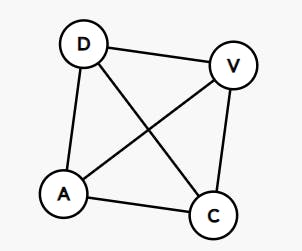Unveiling the Inner Workings of Social Network
Understanding Social Network Analysis
Introduction
Welcome to the world of Social Network Analysis (SNA), where we'll delve deep into the mechanics of the algorithms, data structures, and techniques that power your social media experience. Whether you're a casual user or a curious newcomer, join us as we unravel the intricacies of how these platforms represent and recommend content to you.
The Social Network Web - Graph Theory at Play
Imagine social media as a vast web, where each user is a dot (node), and the connections between them are threads (edges). This web forms a graph, and within computer science, graphs are cherished. Each user represents a node, while the connections take the form of edges. Algorithms like Depth-First Search (DFS) and Breadth-First Search (BFS) navigate this web, helping platforms understand your friends and connections.

Let's take a real-world example: imagine 4 friends A, C, V, and D as nodes in this social network graph. When A likes a post shared by V, V shares a video of cute cats posted by D, and D comments on a meme posted by C, these connections between them form the digital threads of this intricate web.
Algorithms: The Brain Behind the Curtain
Algorithms serve as the invisible architects that shape your online world, connecting the dots and creating personalized connections and recommendations.
Friend's Activity Algorithm:
- Imagine A, your close friend is actively engaged in funny cat videos. The Friend's Activity Algorithm takes notice of this and suggests these cat videos to you as well. Why? Because if A finds them amusing, likely, you will too.
Content-Based Algorithms:
- Suppose V, whose posts you often engage with, frequently shares memes and humorous content. The Content-Based Algorithm recognizes this pattern and starts recommending more funny memes to you.
Collaborative Filtering Algorithm:
- Let's say you and C share a passion for watching funny cat videos and often like each other's posts about it. When C discovers a trending cat video compilation, the Collaborative Filtering Algorithm suggests it to you, knowing your shared interest in adorable felines.
Matrix Factorization Algorithm:
- Consider a scenario where you and D both enjoy memes and funny content. If you've liked a meme about cats and another about humor, the Matrix Factorization Algorithm might recommend a hilarious meme since others who liked those two posts also enjoyed similar content.
PageRank Algorithm:
- The PageRank Algorithm ensures you see popular and influential posts. So, if A, V, D, and C have posts that gather a significant following, those posts are more likely to appear on your feed.
Machine Learning in SNA
Machine learning enhances the accuracy and personalization of social network analysis in various ways, making your experience even more tailored to your preferences.
Recommendation Systems:
- Machine learning models power recommendation engines. They analyze your interactions with A, V, D, and C, identifying patterns to suggest posts, connections, and groups aligned with your interests in funny cat videos and memes.
Sentiment Analysis:
- Imagine V posts a meme, and D comments with laughter emojis, while C shares a cat video with heartwarming comments. Sentiment analysis using natural language processing (NLP) helps the platform understand the sentiment in these interactions and ensures a balanced representation of different types of humor.
Anomaly Detection:
- Machine learning algorithms detect unusual behavior. If someone, like an unknown account, tries to disrupt the enjoyment of funny content with inappropriate material, these algorithms can flag and prevent such activities.
Community Detection:
- Clustering algorithms identify communities of users with similar interests. Suppose there's a Community where A, V, D, and C actively engage. Machine learning helps the platform identify and cater to this community's interests more effectively.
Personalization:
- Machine learning models analyze your interactions with A, V, D, and C to predict your future engagement. If you've frequently liked A's cat video posts, the platform may suggest more cat-related content to keep you entertained.
Fraud Detection:
- Machine learning models are vigilant against fraudulent activities. If an account impersonates A or C, these models can detect and prevent such impersonation.
Content Moderation:
- Machine learning models assist in content moderation. They can identify and flag inappropriate comments or posts, ensuring a safer and more respectful online environment for A, V, D, C, and all users.
Conclusion
As we conclude our exploration of Social Network Analysis (SNA) and the ingenious algorithms powering it, remember that we've merely scratched the surface. SNA is akin to a vast puzzle with numerous pieces, and we've introduced only a few. So the upcoming blogs, we'll delve deeper into each piece of this puzzle, offering a closer look at how these algorithms work and exploring different facets of SNA.

